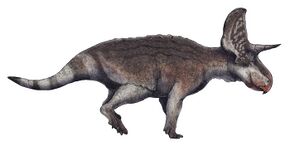Biology:Turanoceratops
| Turanoceratops | |
|---|---|

| |
| Life restoration of Turanoceratops tardabilis | |
| Scientific classification | |
| Domain: | Eukaryota |
| Kingdom: | Animalia |
| Phylum: | Chordata |
| Clade: | Dinosauria |
| Clade: | †Ornithischia |
| Suborder: | †Ceratopsia |
| Clade: | †Euceratopsia |
| Parvorder: | †Coronosauria |
| Superfamily: | †Ceratopsoidea |
| Genus: | †Turanoceratops Nesov et al., 1989 |
| Type species | |
| Turanoceratops tardabilis Nesov et al., 1989
| |
Turanoceratops ("Turan horned face") is a genus of herbivorous ceratopsian dinosaur from the late Cretaceous Bissekty Formation of Uzbekistan. The fossils dated from the mid-late Turonian stage, roughly 90 million years ago. The skull bore a pair of long brow horns like those seen in the Ceratopsidae, although Turanoceratops appears to have been transitional between earlier ceratopsians and ceratopsids, and not a ceratopsid itself.
Discovery and naming
From the 1920s onwards, Soviet scientists discovered fragmentary fossils near Dzharakuduk in the district Navoi Viloyat, leading them to the conclusion that some ceratopsid must have been present. In 1988, paleontologist Lev Aleksandrovich Nesov based on these published the name Turanoceratops tardabilis,[1] but did not provide a description so that for the time being it remained a nomen nudum. In 1989, Nesov, L.F. Kaznysjkina and Gennady Olegovich Cherepanov validly named the type species Turanoceratops tardabilis. The generic name is a combination of Turan, an old Persian name for Turkestan, the general region of the finds, and ~ceratops, "horned face", a usual suffix in ceratopian names. The specific name means "retarding" in Latin, referring to the protracted research.[2]
The holotype, CCMGE No. 251/12457, consists of a damaged left maxilla, the tooth-bearing upper jaw bone. Other fossils have been referred but some of these later were proven to have belonged to other types of dinosaur. A braincase e.g. (specimen CCGME 628/12457) was shown to be of a sauropod, while presumed frill material actually represented ankylosaur armour plates. Authentic material includes postorbitals with brow horn cores, teeth, a predentary and limb elements.
In 2004, Peter Dodson considered it a nomen dubium,[3] but in 2009 Hans-Dieter Sues concluded that it was a valid taxon.[4]
Description

Turanoceratops was a relatively small animal. In 2010, Gregory S. Paul estimated its length at two metres, its weight at 175 kilogrammes.[5]
Sues in 2009 determined some typically basal traits, indicating a lower position in the evolutionary tree, and some more derived traits, showing a higher position. Basal traits are the variably developed secondary ridges on the tooth crowns and the possession of just two or three teeth per tooth position. Derived traits, relative to the more basal Zuniceratops, are the increase of the number of teeth to two or three and the possession of two roots per teeth. More general derived traits are the exclusion of the frontal bone from the upper rim of the eye socket and the presence of incipient cavities in the skull roof.[4]
Classification
Turanoceratops belonged to the Ceratopsia (the name is Greek for "horned face"), a group of herbivorous dinosaurs with parrot-like beaks which thrived in North America and Asia during the Cretaceous Period, which ended 66 million years ago. All ceratopsians became extinct at the end of this period. A 2009 study led by Hans-Dieter Sues analysed additional fossil material of Turanoceratops and concluded that, contrary to expectations, it represented a true (though "transitional") member of the family Ceratopsidae. If correct, it would represent an Asian ceratopsid. At the time of publication this would have been unique, as all other ceratopsids known to that point were from North America.[4] Some scientists, such as Andrew Farke, disagreed with Sues' findings. Farke and colleagues ran an independent phylogenetic analysis of the new Turanoceratops fossils and found that it was a close relative of Ceratopsidae (the immediate sister group) but was not a true member of that clade.[6] Sues and Alexander Averianov criticised that analysis, arguing that Farke and colleagues misinterpreted or mis-coded some characteristics of the fossil in their analysis.[7] However, Xu et al. (2010) conducted a phylogenetic analysis and concluded that Turanoceratops was more derived than Zuniceratops and was outside of Ceratopsidae, because it lacks several important synapomorphies of this group.
Paleobiology
Turanoceratops, like all ceratopsians, was a herbivore. During the Cretaceous, flowering plants were "geographically limited on the landscape"[clarification needed][citation needed], and so it is likely that this dinosaur fed on the predominant plants of the era: ferns and conifers. It would have used its sharp ceratopsian beak to bite off the leaves or needles.[citation needed]
See also
References
- ↑ Nessov L.A., 1988, "[Assemblages of vertebrates of the late Mesozoic and Paleocene of Middle Asia]", Trudy XXXI Sess. Vsesoyuz Paleont. Obshchestva. Nauka, Leningrad, pp 93–101
- ↑ L.A. Nessov, F. Kaznyshkina, & G.O. Cherepanov, 1989, "Ceratopsian dinosaurs and crocodiles of the middle Mesozoic of Asia", In: Bogdanova & Khozatsky (eds.) Theoretical and applied aspects of modern paleontology, pp 142-149
- ↑ H. You and P. Dodson, 2004, "Basal Ceratopsia". In: D. B. Weishampel, H. Osmolska, and P. Dodson (eds.), The Dinosauria (2nd edition). University of California Press, Berkeley pp 478-493
- ↑ 4.0 4.1 4.2 Sues, H.-D., and Averianov, A. (2009). "Turanoceratops tardabilis—the first ceratopsid dinosaur from Asia." Naturwissenschaften, doi:10.1007/s00114-009-0518-9.
- ↑ Paul, G.S., 2010, The Princeton Field Guide to Dinosaurs, Princeton University Press p. 283
- ↑ Farke, A., Sampson, S.D., Forster, C.A., Loewen, M.A. (2009). "Turanoceratops tardabilis—sister taxon, but not a ceratopsid." Naturwissenschaften, 7 May 2009. doi:10.1007/s00114-009-0543-8.
- ↑ Sues, H.-D. and Averianov, A. (2009). "Phylogenetic position of Turanoceratops (Dinosauria: Ceratopsia)." Naturwissenschaften, 20 May 2009. doi:10.1007/s00114-009-0552-7.
Wikidata ☰ Q134820 entry
 |


